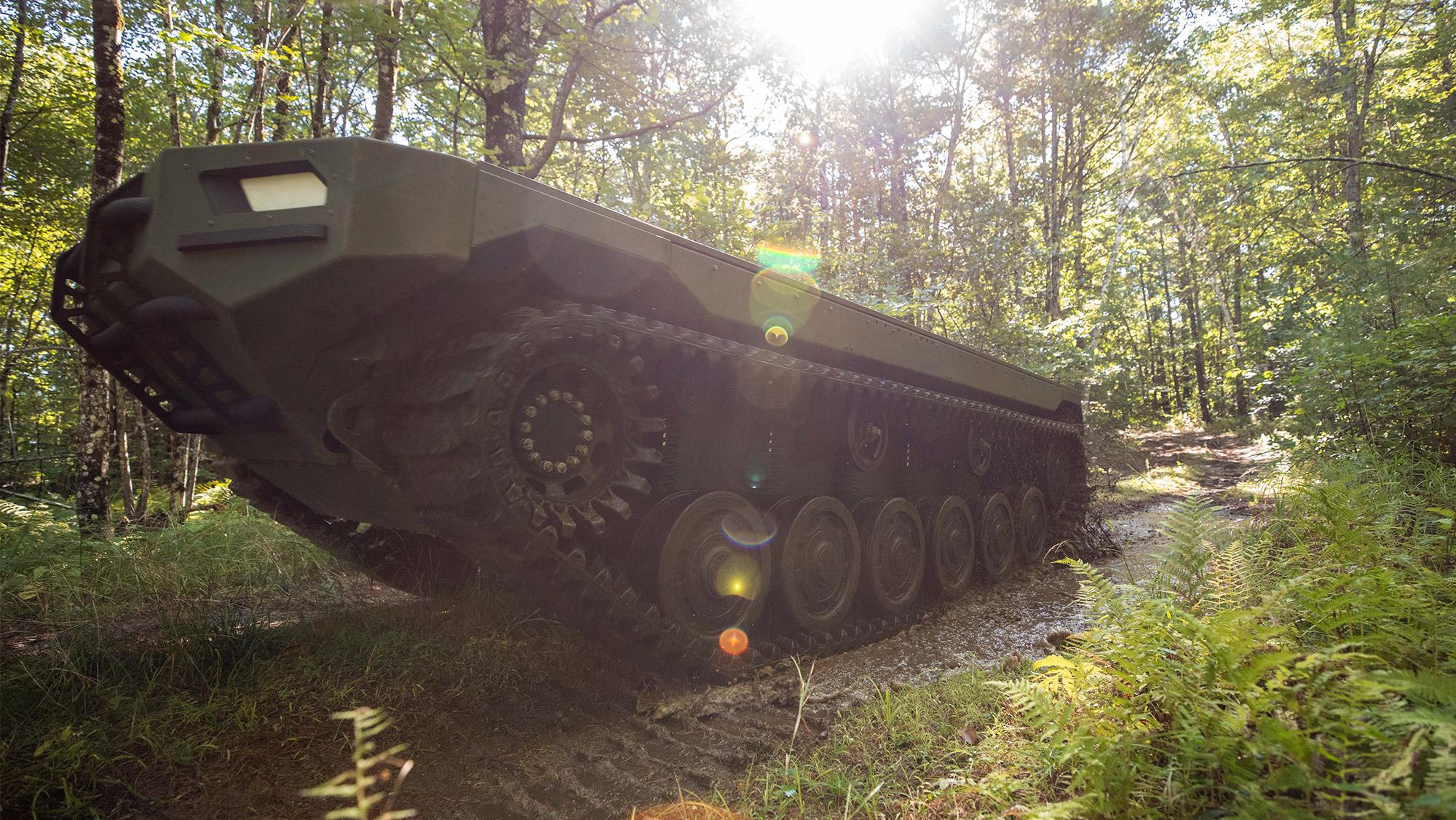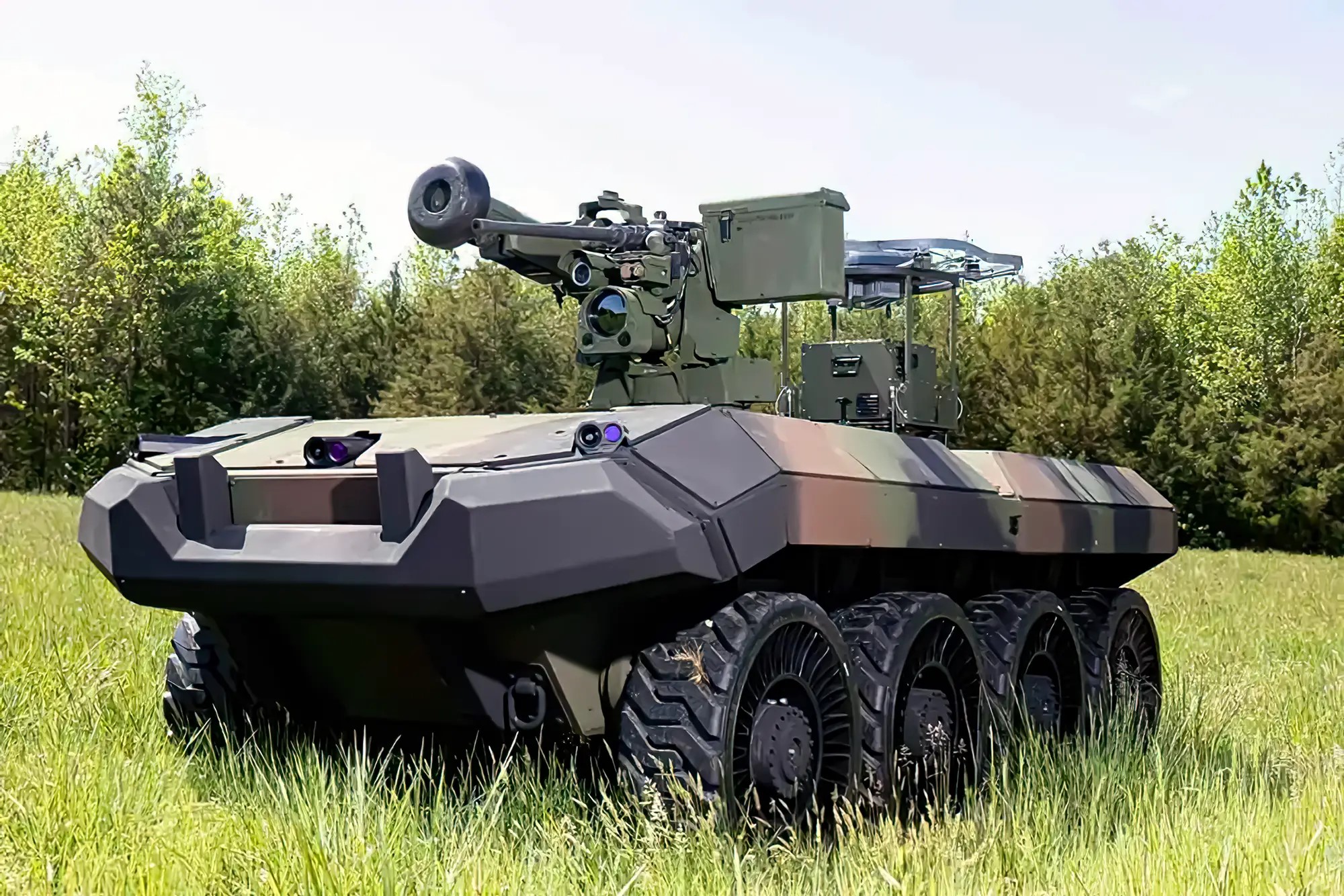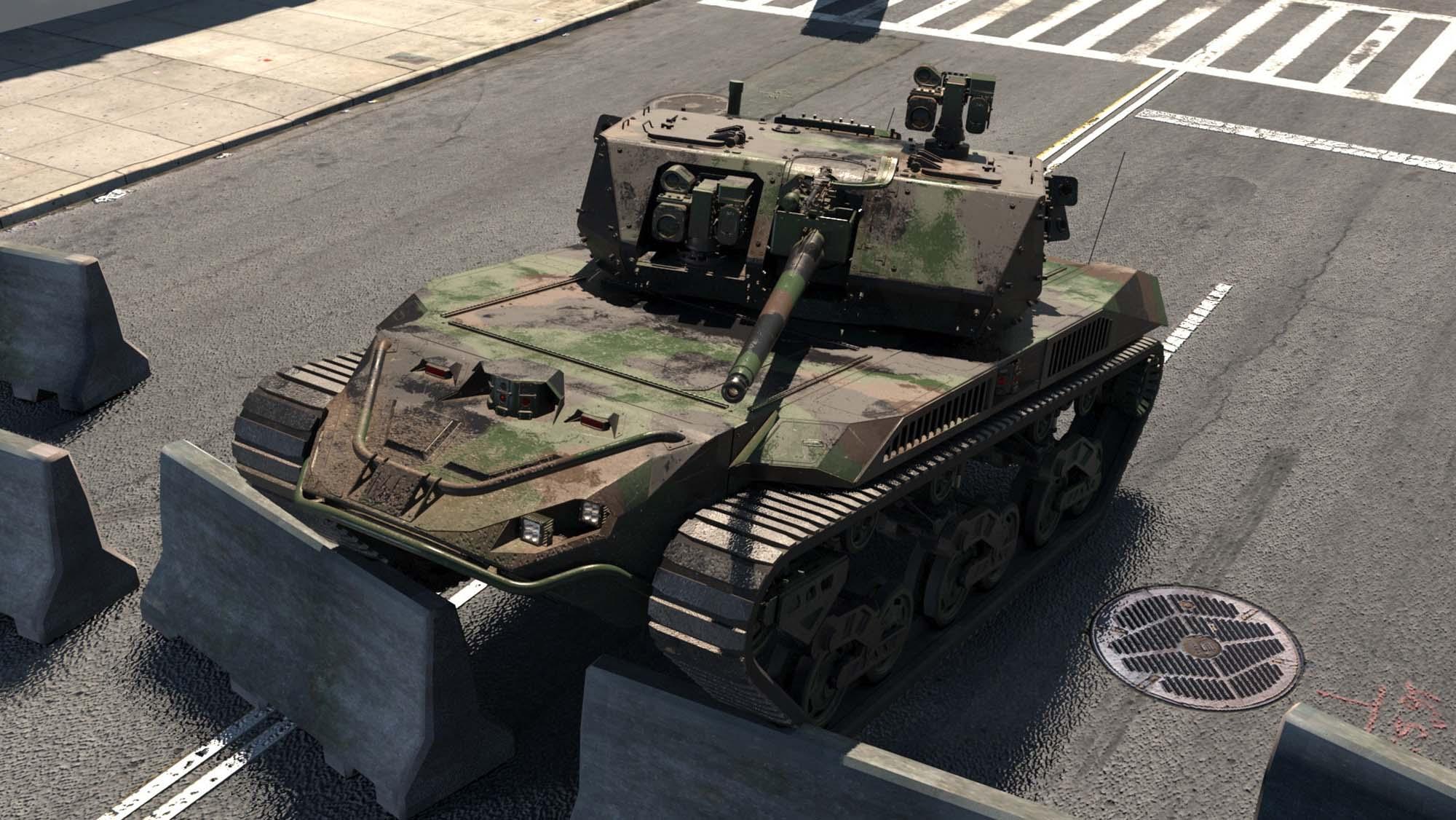The US Army is developing a modular robotic combat vehicle that is comparatively light and manoeuvrable, while still suitable for a variety of missions.
The Robotic Combat Vehicle (RCV) Campaign Plan was established in January 2019 to develop a family of three armed uncrewed ground vehicles (UGVs) of varying size and with distinct capability and mission profiles. These included: the RCV-Light (RCV-L) vehicle, with maximum dimensions of up to 569×224×239 cm (LWH), and weighing up to 10 tonnes, with limited survivability and lethality; the RCV-Medium (RCV-M), a 10–20 tonne class vehicle capable of defeating light- to medium-armoured threats; and the highly-survivable RCV-Heavy (RCV-H) weighing up to 30 tonnes. The latter is essentially an unmanned fire support vehicle, armed with a large calibre cannon for engaging heavily armoured threats.
The basic vision for the RCV calls for joint operations with armoured fighting vehicles such as the Stryker, M2 Bradley, and the Bradley’s designated successor, the XM30 Mechanized Infantry Combat Vehicle (MICV). The RCVs would perform armed overwatch, deploy as scouts ahead of manned vehicles, secure the flanks of manned formations, and assist in obstacle breaching. Depending on the state of artificial intelligence (AI), the robotic vehicles will be either remotely controlled from within the manned vehicles they are escorting, or deploy with at least limited autonomy. Remote control is planned to be the norm initially.
One size fits most
Field testing using surrogate demonstrators began in 2020. This included integration of the technology demonstrators into platoon-level tactical exercises and training scenarios. Mounted weapons testing began in 2021, and included the remote-controlled, targeted firing of machine guns, grenade launchers and Javelin missiles. Lessons from the evaluation scenarios and exercises helped the Army refine technical and performance requirements of future production RCVs, and continue to guide development of future tactics, techniques and procedures for manned-unmanned operations.

Credit: US Army
By summer 2023, the Army had decided to defer development of both the RCV-M and RCV-H. “The Army is still broadly […] interested in robots of many different sizes. But we’re focusing on RCV-L because we think that’s a necessary first step before going to larger platforms,” said Douglas Bush, Assistant Secretary of the Army for Acquisitions, Logistics, and Technology, in August 2023. By October 2023, the service went a step further, announcing that it would now pursue a single, common RCV chassis which can be variably configured for missions previously allocated to either the notional RCV-L or RCV-M platform. FY 2025 Army budget documents confirm that “the Robotic Combat Vehicle (RCV) has transitioned from a family of light, medium, and heavy variants to a single vehicle approach with a common chassis”.
Major General Glenn Dean, Program Executive Officer Ground Combat Systems (PEO GCS), explained that the change was influenced by the results of a three-month evaluation cycle of RCV surrogates conducted in mid-2022. “The outcome of the experiment [found] we really need a modular platform that kind of falls in between the [light and medium],” Dean stated in October 2023. “It can be a little bit bigger than we were allowing the [RCV] light to be, but it doesn’t need to be as big as we were expecting the medium to be because what we found is, the available options for payloads that exist in the defense industry right now could […] fit on that smaller platform.” The capabilities of the former RCV-H concept are not being considered for the common chassis, which would be too small to accommodate the large-calibre gun. Aside from the size factor, the Army had already decided by 2022 to defer the RCV-H indefinitely after concluding that remote operation of a large calibre cannon would not be practicable.
Competition
The Engineering and Manufacturing Development (EMD) phase for the objective RCV was initiated in March 2023 with release of the Army’s Request for Prototype Proposal. At that point the requirements were still geared toward the dedicated RCV-L variant. The prototyping contracts were awarded in September 2023 to four companies: General Dynamics Land Systems (GDLS), McQ, Oshkosh Defense and Textron Systems. These awards constitute the RCV programme’s Phase I, Platform Prototype Design and Build. The contracts set a deadline of August 2024 for delivery of two prototype vehicles per competitor. As described by the Army at the time, the full system prototype award constituted part of the RCV-L Middle Tier Acquisition – Rapid Prototyping programme. “This marks the official transition for us out of experimentation and movement to a fieldable RCV platform prior to 2030,” said Steven Herrick, RCV programme manager.

Credit: Oshkosh Defense
The Army has laid out numerous requirements which all the contestants must fulfil. As with the original RCV-L concept, the modular platform can be sling-loaded by rotary lift aircraft; the Army hopes – but does not require – that the common RCV chassis can also be transported internally by CH-47 helicopters. According to Maj Gen Dean, the initial focus will be on reconnaissance capabilities and payloads, including an onboard tethered UAV of the companies’ choice. Each design must also include a Common Remotely Operated Weapon Station (CROWS) capable of deploying Javelin anti-tank guided missiles (ATGMs). Future payloads will include smoke and obscurants, electronic warfare, and counter-drone capabilities, as well as chemical, biological, radiological and nuclear (CBRN) sensors.
Dean cited the performance of surrogate RCVs during major test exercises at the National Training Center in California to underscore their operational potential. “They had robots leading flank attacks with smoke and electronic warfare all employed at the same time. They’ve used them for an economy of force, and we had two robots holding off an entire US infantry company and performing very successfully,” Dean told the press in October 2023.
The Army expects to receive its four RCV prototypes in summer 2024, following which the four designs will undergo a year of intense testing and evaluation by combat units. The evaluation will have a new focus, geared to their suitability as an RCV common chassis rather than as a dedicated RCV-Light. The Army plans to downselect to a single design in FY 2025 for Phase II, Full-System Prototype Design and Build; if funding permits, the service could award Phase II contracts to two firms. The selected contractor(s) will finalise system designs, build and deliver up to nine full system prototypes in FY 2026. A production decision is scheduled for FY 2027, and the Army intends to field the first operational unit in FY 2028.

Credit: Textron Systems
Challenges and concerns: autonomy systems
While the Army projects confidence in this schedule – and regarding the prospects of acquiring a viable vehicle chassis – some challenges and concerns regarding the programme remain. A major concern is the state of vehicle autonomy. The Robotic Technology Kernel (RTK), also known as the Autonomous Robotic Control System (ARCS), is a cross-vehicle library of modular software packages for autonomous platforms, responsible for such factors as navigation planning, obstacle detection and avoidance, as well as speed and steering control. It forms the core of the autonomous capabilities package of the RCV. Unlike most other software and hardware components of the robotic combat vehicle, the Army is developing this technology internally. This is partly to avoid reliance on a single vendor for this key capability, and partly to enable the service to apply the software to other vehicle systems without negotiating new contracts. Industry sources warn that the Pentagon is overlooking commercially-designed autonomy systems that are already more mature than ARCS; as a result, they say, the service – at least initially – risks fielding robotic combat vehicles that are less capable than they could be.
The military acknowledges that development of RTK has lagged behind expectations. Ongoing testing of road-capable unmanned vehicles shows that the software has limited ability to independently interpret and master numerous types of obstacles, including bridges and road bumps; this leads to the system automatically ‘dropping out’ of autonomous mode and waiting for human intervention. Between January and April of 2024, the Pentagon has awarded 11 contracts to industry in an effort to supplement RTK. These include three Other Transaction Authority (OTA) contracts for RCS autonomy software development over the next two years, plus another eight awards to develop prototype software in the fields of autonomous navigation (vendors: Forterra, Kodiak Robotics, Neya Systems and Overland AI), machine learning and autonomy (Applied Intuition and Scale AI), and software system integration (Anduril and Palantir). “We are excited to work with these best-in-class autonomy providers, software experts, and systems integrators as we drive towards merging software capabilities developed through the RCV software acquisition pathway (SWP) into the RCV full system prototype,” RCV product manager Steven Herrick said in a 3 April 2024 press release. “Together, these companies will support the [RCV] program in developing a robust, capable, and compliant software system that can operate in a variety of autonomous modes and rapidly integrate a variety of payloads as they become available.”

Credit: McQ
Challenges and concerns: remote control
The limited autonomy translates to an enduring requirement for remote control for most RCV functions, at least for the first few years of service. This in turn will require soldiers controlling the robots to stay within close proximity and line of sight to ensure the fidelity of the radio link or ‘tether’. The operating concept calls for teams of two soldiers to control the robot from the back of an armoured vehicle trailing the RCV. The integration of the RCV-L and RCV-M surrogates into the Army’s Project Convergence Capstone 4 experiment conducted in California in February–March 2024 provided new details regarding the reliability of the tether. In open terrain, the control vehicle must stay within 1,000 to 2,000 m of the robot. Since obstacles degrade and block the radio signal, operations in urban or forested terrain can require soldiers to be as close as 500 m to the RCV. This conflicts with the Pentagon’s stated intent to “[use] robots, not soldiers, to make first contact with the enemy”, locating and dislodging opposing forces or repelling the first hostile attack wave.
“We need to get [soldiers] a little further back,” said Brigadier General Geoffrey Norman, who retired as director of the Next-Generation Combat Vehicle Cross Functional Team in July 2024. “If they’re inside the [enemy’s] direct fire range, whether it’s from a cannon, direct fire or anti-tank guided missiles, those control vehicles are very vulnerable.” Norman has proposed configuring the RCV and the control station for satellite communications to augment line-of-sight relays. However, other Army sources predict technical difficulties integrating satellite terminals into the hardware mix. General Dean has warned that satellite signals might arrive with more than 250 milliseconds of latency. While this might not be relevant in the majority of operational scenarios, it could be problematic when driving the RCV at high speeds or engaging a moving target with onboard weaponry, Dean said. Another alternative being examined is mesh networking, in which the radios of other nearby vehicles or uncrewed aerial vehicles (UAVs) act as repeaters for the control signal. This would obviate the need for line-of-sight contact between the control vehicle and the RCV. Even here, there is loss of signal strength and cohesion with each relay procedure, and a line-of-sight would still be required between the various intermediate radios. Maintenance of an uninterrupted communications link is vital for such applications as engaging enemy forces with weapons (which requires a weapons-free decision by a human operator) or sending situational awareness updates back to unit commanders.

Credit: US Army
Another factor is the extremely high demand for communications bandwidth on the modern battlefield, even before the RCV is added to the mix. The communications demands of the robotic combat vehicles will vary widely, depending on the mission being executed and the level of autonomy available for that given mission. “We can’t[…] lock down a whole bunch of bandwidth or a whole section of our network capability exclusively for robots because there are going to be a lot of demands,” General Norman said. Continued research into stronger and more secure communications links will be one priority as the programme moves forward.
Going forward
Despite these efforts, the military concedes that the current limitations of vehicle autonomy will limit the types of missions the early robots can execute. Surveillance missions such as armed overwatch – including the capacity to engage approaching forces from a fixed position – are considered the most likely applications for the first operational units. General Norman acknowledged that the service would need to lower expectations for the time being, but defended the decision to press forward now. “I temper my enthusiasm with the reality that I see when I look at the state of technology, I have to take a bit of an appetite suppressant and realize that […] we just need to get capability out to the field,” Norman said in July 2024. “It’s not going to be as autonomous or as capable as we want or as we might desire but we need to start getting these capabilities out into the hands of soldiers and units and forces command so they can start experimenting.”
Sidney E. Dean



